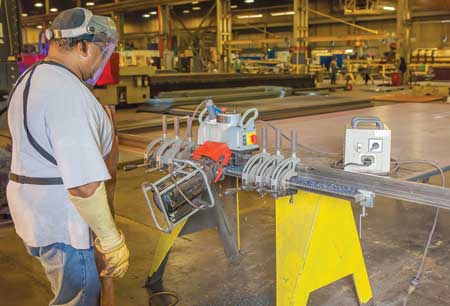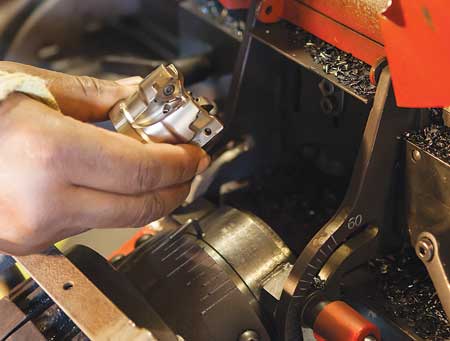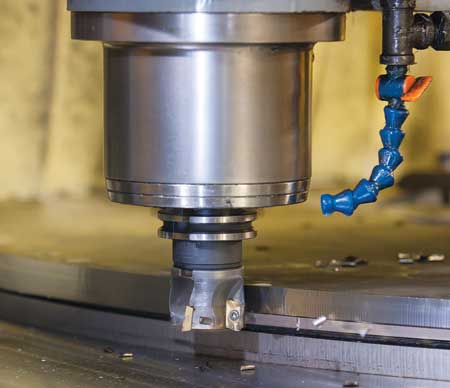

Seco helped Olympic improve cutter life and surface finish, as well as reduce tooling costs, for an unconventional machining operation that cuts angles or bevels on opposing edges of a steel plate. With a Seco Square 6 face mill, Olympic generates cuts that ensure smooth welded seams when the plates are rolled to form a cylinder or tank.

Olympic relies on Seco tooling to improve the value-added machining services - such as cutting the profiles of these large cylindrical parts - offered to Olympic customers.

"The Seco Power Turbo Mill designed for heavy duty, maximum metal removal, but with free cutting inserts, allowed Olympic to triple feeds and speeds for profiling large tough to machine parts," said a company spokesperson.
More and more, manufacturers are asking their suppliers to provide raw materials that are configured to the manufacturer's specific production needs. Starting with stock that can plug directly into the manufacturing process saves the time and money that would be spent preparing it for use. As a result, commodity distributors are moving to offer their customers additional value-added services, heightened responsiveness and lower costs while continually improving their own operational efficiencies.
Olympic Steel is an excellent representative of this trend. Founded in Cleveland in 1954 as a steel service center to distribute flat rolled products, the company began with no processing equipment. Through a progression of expansions and acquisitions, Olympic Steel now has 18 locations in North America and distributes and processes alloy, coated, cold- and hot-rolled carbon steels as well as specialty metals such as stainless steels and aluminum. A wide range of OEM manufacturers employ Olympic's output on their production lines to make a varied array of products.
Olympic management's quest for growth opportunities beyond basic distribution, combined with customer interest in additional services, prompted expansion of the company's value-added capabilities, according to Curt Olsen, Project Manager at Olympic Steel's Plate Division located in, Plymouth, MN.
Those expanded capabilities initially involved the addition of oxyfuel, plasma and laser cutting systems that enabled the company to provide steel plate in shapes and sizes close to what the customers would actually use in their production operations.
Olympic then moved from supplying rough shapes into producing parts custom-machined, and/or formed, for use on specific manufacturer's production lines without further processing. Three years ago, Olsen began to put together a machining operation at the Minneapolis facility. Today that shop relies heavily on cutters and inserts from Seco Tools to optimize a portable beveling process and machining operations on its six Haas CNC vertical milling machines with work envelopes from 40"x 26" to 84"x 144". The shop also has eight lasers, two plasma, two oxyfuel burner and two high-definition plasma machines. These six burning machines, along with deburring and shotblasting equipment, round out the large processing equipment capabilities. The operation has about 100 employees, including 15 machinists. Many of the parts processed in the facility are large, up to 5" thick and weighing as much as 2,800 lbs; most are destined for use in heavy and industrial machinery, as well as in agricultural and transportation equipment.
In general, Olympic begins the process when a rough shape is burned from 96"x 240" plate with a laser, oxy fuel or plasma cutter. After deslagging, machining typically involves rough contour side milling of the plate periphery using 1.250" and 2" diameter inserted endmills tooled with 0.708" (18 mm) and 0.472" (12 mm) inserts. Olsen pointed out that the edges of the burned plates have a heat-affected zone that is hard and brittle, so a conventional, as opposed to climb milling, technique is used to extend tool life. "In conventional milling, the insert gets into the soft material and comes through the hard material," he said. The insert takes a helical path around the plate, ramping down as it proceeds along the part periphery. Maintaining contact with the part assures consistent chipload and constant heat in the tool and part, and enables the tool to be run faster without failing.
Typical part volumes range from single-digit runs to as many as 500 pieces. For one customer, Olympic produces a selection of different part numbers totaling 4,000 pieces a day. "The different parts are assembled into sequential kits, so when the customer's assembly line receives the kits, the employees can simply pull the part and put it into their fixtures, in the right order without extra steps," said Olsen.
Most of the shop's output is used to build inventory to meet blanket orders. Normal lead time is three or four weeks. But changes in customer business or other factors can drop inventory levels below what will be needed to keep the customer's production line running, and rush jobs result. "You go home at night and think everything is fine. Then you come in 8 or 12 hours later and you have three jobs that popped out of nowhere that you have to get done and on a truck by the end of the day or the end of the week," said Olsen. "We get the plate on the machine, cut it, deburr it and get it to the machining center or shotblaster all in a day's time."
Olsen said maintaining responsiveness and quality depends on machining capacity, which in turn depends on maximizing machine utilization and productivity. Accordingly, reducing cycle time is crucial. As an example, Olsen described peripheral milling of the edges of a large offroad equipment part using an inserted endmill. The operation was taking 60 minutes. "I thought we could do better, and we worked and worked and got the cycle time down to about 45 minutes," he said. "Then we kind of hit a wall." Olsen was convinced further improvement was possible, but he needed help in choosing insert grades. "I can look at a catalog and have no idea what insert grade is best. I needed someone to come in and tell me that."
Olsen contacted Seco and worked with Rob Juetten, a technical specialist with Seco Tools. "We showed Seco the baseline and what my goal was," said Olsen. "They met that goal and exceeded it big time. With Seco's recommendations regarding insert grades, cutting time is now about 15 minutes. We kept having the Seco folks come in, and we kept pushing the envelope. They accepted that challenge and recommended we use R220.69-02.00-18-5AN Power Turbo Mill designed for heavy duty, maximum metal removal, but with free cutting inserts that made for efficient use of Olympic's machine tool power, even in the shop's demanding applications and difficult materials. We went from 35 IPM to 150 IPM feedrate with a 0.018 inch chipload. We easily tripled feeds and speeds. We can mill faster than we can cut with HD gas or plasma." Olympic's efforts to boost productivity are ongoing, with emphasis on the most time-consuming operations. "Typically the roughing operations are the biggest chunk of time, so that is what we are going to focus on first," said Olsen.
Olsen also sought Seco's assistance regarding an unconventional machining operation that is an important part of Olympic's plate-processing business. The operation involves cutting angles or bevels on opposing edges of a plate so a smooth welded seam is possible when the plate is rolled to form a cylinder or tank. The bevels are cut with a unit that rides on a rail that is clamped to the plate. The unit has a spindle motor fitted with a milling cutter that moves down the rail and mills a proprietary bevel. A single pass will create the bevel on thinner workpieces, while as many as five passes are necessary with 1.181" (30 mm) thick material.
The beveling unit was supplied with a proprietary milling cutter costing about $1,400 and featuring inserts with two cutting edges. The machining set-up by nature was unstable, and both cutter and insert life were short. Seco suggested applying a standard five-insert R220.96-02.00-08-5AN Square 6 face mill with a spindle interface modified to fit the spindle motor. The cutter is designed to provide high performance for a wide range of materials, machining conditions and operations such as facemilling, plunging and square shoulder milling.
The cutter's five inserts each had six cutting edges. "The inserts they picked were beefy, heavy inserts that can take abuse and vibration," said Olsen. "The off-the-shelf Seco cutter runs us about $300. So there is less cost for the cutter, less cost for the inserts and a much better-looking part. The customer is very pleased with the surface finish in a very tough environment. It was a problem and it is solved thanks to Seco."
Problem-solving and productivity consulting is another value-added service Olympic often provides to its customers. For example, achieving tighter tolerances may appear to be universally beneficial. A tight-tolerance machined part will fit into a production process with minimal manipulation and thereby save production time and money. "The more precisely parts can fit together, the less time the customer has to spend manipulating parts to fit," said Olsen. On the other hand, achieving tighter tolerances increases machining costs, so Olympic will discuss with the customer the application of the part to determine exactly the level of precision that is necessary, and suggest cost-saving alternatives if desired.
For Olympic, part quality is just as important as shorter cycle times and delivery responsiveness. All the shop's machines are equipped with probes to check part location before machining as well as post-machining dimensions. "We check all the parts in real time so the operators see that the part is good before they pull it off the machine," said Olsen. The move to internal machining operations further increases the company's control over the quality of the parts it produces, as it enables Olympic to perform operations that formerly were handled outside the shop. "For our customers with more demanding quality standards it is imperative that we run the parts internally, so we have control," said Olsen. "We want to make sure we do not ship a bad part to a customer. With that said, tooling from Seco has definitely contributed to the success we have had, and looking forward, I foresee Seco continuing as an integral part of new growth."
For more information contact:
Seco Tools Inc.
2805 Bellingham Drive
Troy, MI 48083
248-528-5444
secotools.us@secotools.com
www.secotools.com
Olympic Steel Corporate Headquarters
5096 Richmond Road
Bedford Heights, OH 44146
216-292-3800
www.olysteel.com